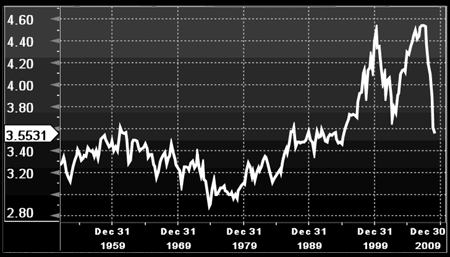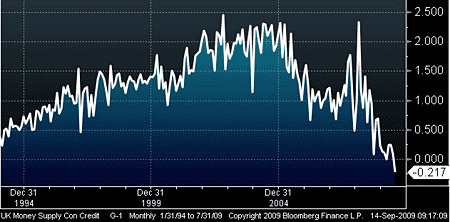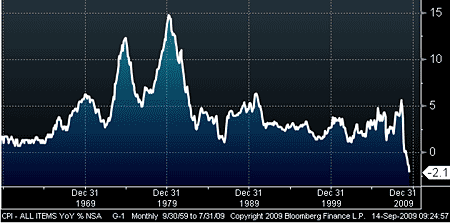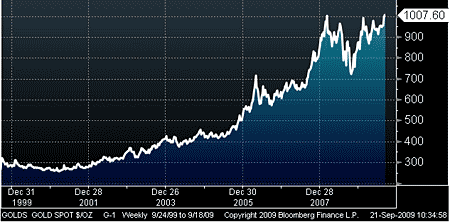Investment strategies for both inflation and deflation
The global economy is at a major turning point: will inflation or deflation win out over the next few years? With strong arguments for both cases, it is important to to invest in a way that gives plenty of profit if you're right and limits the losses if you're wrong. Cris Sholto Heaton explains how.

Last week I looked briefly at the inflation/deflation debate and what it meant for equities. I focused on the two types of leverage a firm can have financial and operating and how this affects its profits and chances of survival.
Today I'm going to focus on a few other aspects of this problem. In particular, I'll take look at the broader investment implications and run through some points for bond investors to keep in mind.
But to begin with, let's quickly reflect on why the inflation/deflation outlook is now the hardest problem in investment to crack
MoneyWeek
Subscribe to MoneyWeek today and get your first six magazine issues absolutely FREE

Sign up to Money Morning
Don't miss the latest investment and personal finances news, market analysis, plus money-saving tips with our free twice-daily newsletter
Don't miss the latest investment and personal finances news, market analysis, plus money-saving tips with our free twice-daily newsletter
Strong arguments on either side
Both sides of the inflation/deflation debate can make a strong case. Firstly, many Western countries have had their second shattering collapse in household wealth in ten years. That has left behind a vast debt burden which consumers are now finally starting to pay down (as the charts below show).
Figure 1. US household net worth as a percentage of GDP

Figure 2. UK net new lending to individuals

We also have a huge amount of spare capacity in the economy caused by the collapse in demand. That includes the labour market, where US unemployment is closing in on its post-war high (see below).
Figure 3. US unemployment rate

These are ingredients for deflation. But on the other hand, we have central banks determined to forestall that, both through increasing the supply of money (quantitative easing) and lowering its cost (interest rates that are a record low and likely to stay that way for a while). Loose monetary conditions like this are naturally inflationary.
Both sides can make a convincing argument on why they will win out. Deflationists point to the experience of Japan after the bubble burst in 1989, where, despite the central bank's attempts at quantitative easing, debt-induced deflation still reigned.
Inflationists say this only proves that Japan was too half-hearted. They claim that other less well-known examples of quantitative easing, such as Japan in the 1930s and the US in 1949, quickly brought about double-digit inflation. Today's central bankers especially Ben Bernanke, who has studied and spoken approvingly of Japan's actions during the Great Depression will not make the same mistake.
A recipe for stagnation
My feeling is that both sides are partly right, and that for the next few years, we will end up with something in between. For now we have deflation across most of the world. In the US, the consumer price index is now falling at a rate not seen since 1949 (see chart below). This could continue for another year or so.
Figure 4. US consumer price index, year-on-year percentage change

As Western central banks see their attempts to reflate having little effect, they will keep interest rates down and increase quantitative easing further. But banks are reluctant to lend, and consumers and business unwilling to borrow more. Instead, the extra liquidity will flow into assets especially foreign ones and commodities (as it already is to some extent).
The combination of higher raw material prices and higher import costs through weaker currencies will create limited inflation in the West. But with labour markets very weak and unions lacking bargaining power, we won't get the wage-price spiral of the seventies. Wages may well suffer deflation, as could the price of many services. Most Western economies are going to feel pretty stagnant and unpleasant.
Meanwhile, emerging Asia lacks the West's huge debt burden and need to deleverage. There is some excess capacity, but given the greater flexibility and faster trend growth of these economies, that should be destroyed or outgrown more quickly. So moderate inflation will return more quickly in Asia in goods, services and wages; some central banks may be raising rates as early as next year.
But in this scenario, the real inflation for Asia is in asset prices. All the excess liquidity from Western economies chases the best growth story and finds it in Asian equities and property. The outcome for bonds could be more mixed; with inflation ticking up, the low yields on top-grade Asian credit may not look that attractive, but some governments and corporates may benefit from a reassessment of how credit-worthy Asian borrowers are becoming.
In contrast to Asia, where many assets will enjoy a renewed bull market, many Western ones will remain in a secular bear market. This includes property, but also equities: the S&P 500 never dipped into the extremes of undervaluation that typically marks a bear market bottom, which suggests we face several years of strong rallies and equally sharp sell-offs. Yields on Western government bonds also generally look too low to be attractive if inflation ticks up to a couple of percent. However, corporate bonds with an investment-grade rating could still represent reasonable value for income seekers.
Not a time for macro investing
One thing to note with this scenario is that it's likely to hurt those who try to play the next few years through a big macroeconomic call. If you're betting on deflation, the obvious choice is government bonds, guided by the Japanese experience where yields kept falling year after year (see chart below). But even weak inflation would make yields on government bonds unattractive; the US five-year treasury currently yields under 2.5%.
Figure 5. Japan ten-year government bond yield

Meanwhile, inflation hawks tend to favour gold. But at over $1,000/oz after an eight-year bull market, gold looks unattractive unless inflation picks up strongly.
Figure 6. Spot gold

Ultimately, I think high inflation very possible; barring major technological breakthroughs that suddenly accelerate real GDP growth, Western governments have no option but to generate inflation (and thus higher nominal GDP growth) in an effort to cut their crippling debt/GDP ratios. But if the point when central banks finally gain traction is ten years away or so, returns from a hyperinflation bet in the meantime are likely to be disappointing.
In short, we're in a middle ground that doesn't favour big one-way bets. This is a selective market, where you get the best returns by making the best choices within each asset class be it equities, bonds, property or whatever. Around that, we need to be aware of whether we are in a secular bull market (Asia) or a secular bear market (the West), which determines whether holding for the long term or trading within a range is likely to be most productive.
Trying to limit the downside
Of course, we can't be absolutely sure what the outcome will be. The global economy is at a major turning point and anyone who claims they know for certain whether inflation or deflation will win out is dangerously overconfident. So we need to construct our portfolios in a way that gives us plenty of upside if we're right and limits the downside if we're wrong.
I discussed equities in more detail last week (Three reasons to buy this Japanese gaming giant). Equities are a real asset, since earnings and dividends rise in line with inflation over the long run. While they would perform poorly during a seventies-style high-inflation scenario because costs increases can't be passed on instantly, you'd expect them to recover in the long run. Deflation is more dangerous because of the risk that highly leveraged companies won't survive; hence as I mentioned last time, I favour a low leverage portfolio to give some downside protection if true deflation wins out.
But what about bonds? These are a nominal asset and usually have a fixed term until repayment (unlike equities). Higher inflation permanently erodes their returns. So if you think that bonds are attractive now in an environment of low deflation or low inflation, but you expect inflation to pick up five to ten years down the line, you will want to favour bonds or bond funds with lower duration.
Duration is essentially the weighted average of the time when a bond's cashflows will be paid to the holder. So, for example, a bond that pays you £100 in a year's time will have a shorter duration than one that pays you £100 in 20 years (in this case, the durations are actually one year and 20 years respectively). But a bond that pays you £10 a year for ten years followed by £100 will have a shorter duration than one that pays £5 a year for ten years followed by £150, because a larger proportion of the payments are being made earlier.
Bonds with a higher duration are more sensitive to shifts in inflation. This consideration applies even if you were to buy a 20-year bond yielding 5% a year with the intention of selling it in five years time, for example. While you will have received five years' worth of interest payments, if inflation expectations are rising sharply when you come to sell, the resale price of the bond is likely to be less than you paid, giving you a capital loss and reducing your overall return to below 5% a year.
Hence, to limit downside for bonds, I would favour shorter duration funds. MoneyWeek has tipped the M&G Corporate Bond Fund a few times; this invests almost entirely in investment grade debt, yields around 3.4%, and the manager has reduced the duration from 7.1 years to 5.7 years over the last year. This looks reasonable but obviously you need to be ready to get out quickly if inflation shows signs of picking up.
But as I mentioned earlier, I think select emerging market bonds may be more interesting. So far, there are few attractive ways for retail investors to access them but there are signs this is set to change. So I'll be returning to this in a future issue of this email.
Coming soon
Finally this week, I'd like to let you know about a couple of things that are coming up for MoneyWeek Asia. The first is that MoneyWeek is about to launch a blog, with regular comment from all our writers. So from this week, rather than rounding up the news at the bottom of this email, I'll be posting stories on the blog.
The other is that we're looking at a few possible changes and additions to MoneyWeek Asia. Before we go ahead with them, we'd like to know a bit more about what would be useful to you. So we'll be sending out a short survey later this week asking for your views on the service and some background about how you invest at the moment we'd really appreciate it if you could spare a few minutes of your time to fill it in. And as ever, you can email me directly with any comments at crish@moneyweek.com.
This article is from MoneyWeek Asia, a FREE weekly email of investment ideas and news every Monday from MoneyWeek magazine, covering the world's fastest-developing and most exciting region. Sign up to MoneyWeek Asia here
Get the latest financial news, insights and expert analysis from our award-winning MoneyWeek team, to help you understand what really matters when it comes to your finances.
Cris Sholto Heaton is an investment analyst and writer who has been contributing to MoneyWeek since 2006 and was managing editor of the magazine between 2016 and 2018. He is especially interested in international investing, believing many investors still focus too much on their home markets and that it pays to take advantage of all the opportunities the world offers. He often writes about Asian equities, international income and global asset allocation.
Cris began his career in financial services consultancy at PwC and Lane Clark & Peacock, before an abrupt change of direction into oil, gas and energy at Petroleum Economist and Platts and subsequently into investment research and writing. In addition to his articles for MoneyWeek, he also works with a number of asset managers, consultancies and financial information providers.
He holds the Chartered Financial Analyst designation and the Investment Management Certificate, as well as degrees in finance and mathematics. He has also studied acting, film-making and photography, and strongly suspects that an awareness of what makes a compelling story is just as important for understanding markets as any amount of qualifications.
-
 Pundits had a bad 2025 – here's what it means for investors
Pundits had a bad 2025 – here's what it means for investorsThe pundits came in for many shocks in 2025, says Max King. Here is what they should learn from them
-
 The MoneyWeek ETF portfolio – early 2026 update
The MoneyWeek ETF portfolio – early 2026 updateThe MoneyWeek ETF portfolio had a solid year in 2025 and looks well placed for what the next 12 months may bring
